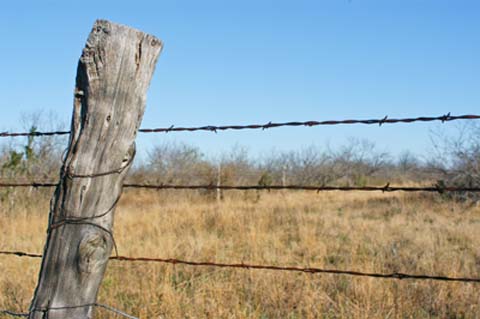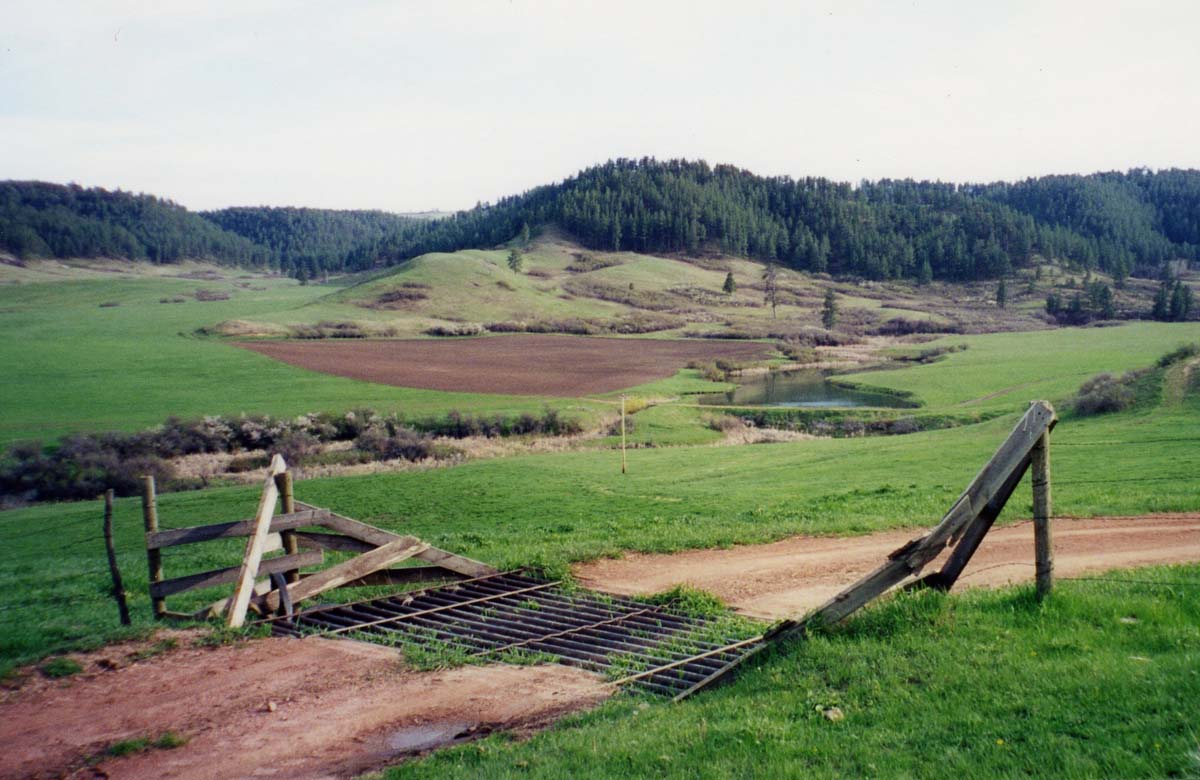Cowboy Jargon
Feb 10, 2022 by Tempe Javitz
Cowboy Jargon
Cowgirls and cowboys have a special vocabulary which is sometimes
confusing to ordinary folks.
Cavvy: A term used to describe the saddle horses kept by a ranch.
Also known as the remuda (another Spanish word). Back in the day, each
cowboy was assigned a ‘string’ of horses that were for his particular use. The
origin of cavvy comes from the Spanish cavvietta or herd of horses.
Barbwire: Strands of wire twisted to hold barbs that would keep livestock in
specific pastures. Most fences had four strands of barbed wire between the fence
posts to keep those naughty cows and horses from straying.

Barbed wire is attached to the post with staples.
Bite the dust: Being thrown from your horse. Not a pleasant experience!
Borrow Pit: This is what we were told as children to call the ditch on each side
of the road, as earth was borrowed to form the roadbed. Pronounced like ‘barrow.’
My California husband thought it was funny when he first heard me refer to the borrow pit.
Boneyard: Cattlemen usually mean a place where they have deposited dead animals or
critters. Also, this expression can refer to a cemetery or boot hill.
Belly Up: To go belly up is to die. Cowboys have also been known to ‘belly up’
to the bar, bringing a stool to the bar to sit and have a drink. I’ve also heard
it used to describe someone who has gone broke.
Brand or branding: Using a hot branding iron, a brand is burned into the hide of
a cow or horse-usually on the left hip. It’s a sign of ownership for your stock.
Most brands also include an earmark for the cattle. Brands are registered with
the state to prevent duplication. It’s a real skill to brand a horse or a cow by
just barely burning the hide enough to create a scar, but not break the skin to bleed.
Rustlers are known to alter brands using a running iron, a plain rod bar. That way
they can draw an alternate brand free style, call it their own, and attempt to sell
the cattle they have rustled.
Break a horse: An expression meaning to train your horse.
Bring up the drag: This means to ride at the back of the herd (in the dust).
Bucket of Blood Saloon: A very rough saloon. The origin of this creative name
comes from a notorious drinking place in Havre, Montana. The name spread from
there. The oldest operating Bucket of Blood Saloon is in Virginia City, Montana.
One of the original gold towns in western Montana. It was built in 1876.
Bunkhouse: The sleeping quarters provided for the cowhands, or miners or loggers.
Bunkhouses were usually of very simple construction, had a pot belly stove for heat
and simple iron framed beds for sleeping. The bunkhouse at my Uncle Junior Spear’s
ranch didn’t even have a closet, just hooks on the wall and a coat rack.
.jpg) My photo of the original bunkhouse at Junior Spear's ranch.
My photo of the original bunkhouse at Junior Spear's ranch.
Camp Robber: The Rocky Mountain jay bird, plump with gray and black feathers.
This jay loves to steal scraps from your campfire.
Cattle Guard: A set of steel or iron rails across a road in cow country. This is
more efficient than a regular wire gate that you have to get out, open and then
shut behind you to keep your cows from wandering. There is a pit underneath the
rails which successfully scares the cows from trying to walk across the rails.
There’s a silly western joke regarding a tourist who asked “What color uniforms
do the cattle guards wear?”

My photo of the horse pasture cattleguard at the Spear O Ranch
Chaps: Leather overalls to protect a cowgirl or cowboy’s legs when riding through
thorny brush. Chaps are also good for protecting your legs if you are thrown from
a horse, or if a horse falls on you. Chaps also offer protection against rain or snow.
Chokecherry: A shrub found in much of the West that bears cherries, black when ripe.
My sisters and I loved to eat them (and so did our horses), while we picked buckets
full to bring home to our mother. She made chokecherry jelly as well as the best
pancake syrup in the world.
To keep up the suspense I won’t bore you with more definitions at this time.
Look for a new western word definition at the conclusion of my future blogs.
Read prior blogs and information about my book about my grandmother Jessamine’s
fabulous photography (coming in late fall) at tempejavitz.com.
Cowgirls and cowboys have a special vocabulary which is sometimes
confusing to ordinary folks.
Cavvy: A term used to describe the saddle horses kept by a ranch.
Also known as the remuda (another Spanish word). Back in the day, each
cowboy was assigned a ‘string’ of horses that were for his particular use. The
origin of cavvy comes from the Spanish cavvietta or herd of horses.
Barbwire: Strands of wire twisted to hold barbs that would keep livestock in
specific pastures. Most fences had four strands of barbed wire between the fence
posts to keep those naughty cows and horses from straying.

Barbed wire is attached to the post with staples.
Bite the dust: Being thrown from your horse. Not a pleasant experience!
Borrow Pit: This is what we were told as children to call the ditch on each side
of the road, as earth was borrowed to form the roadbed. Pronounced like ‘barrow.’
My California husband thought it was funny when he first heard me refer to the borrow pit.
Boneyard: Cattlemen usually mean a place where they have deposited dead animals or
critters. Also, this expression can refer to a cemetery or boot hill.
Belly Up: To go belly up is to die. Cowboys have also been known to ‘belly up’
to the bar, bringing a stool to the bar to sit and have a drink. I’ve also heard
it used to describe someone who has gone broke.
Brand or branding: Using a hot branding iron, a brand is burned into the hide of
a cow or horse-usually on the left hip. It’s a sign of ownership for your stock.
Most brands also include an earmark for the cattle. Brands are registered with
the state to prevent duplication. It’s a real skill to brand a horse or a cow by
just barely burning the hide enough to create a scar, but not break the skin to bleed.
Rustlers are known to alter brands using a running iron, a plain rod bar. That way
they can draw an alternate brand free style, call it their own, and attempt to sell
the cattle they have rustled.
Break a horse: An expression meaning to train your horse.
Bring up the drag: This means to ride at the back of the herd (in the dust).
Bucket of Blood Saloon: A very rough saloon. The origin of this creative name
comes from a notorious drinking place in Havre, Montana. The name spread from
there. The oldest operating Bucket of Blood Saloon is in Virginia City, Montana.
One of the original gold towns in western Montana. It was built in 1876.
Bunkhouse: The sleeping quarters provided for the cowhands, or miners or loggers.
Bunkhouses were usually of very simple construction, had a pot belly stove for heat
and simple iron framed beds for sleeping. The bunkhouse at my Uncle Junior Spear’s
ranch didn’t even have a closet, just hooks on the wall and a coat rack.
.jpg)
Camp Robber: The Rocky Mountain jay bird, plump with gray and black feathers.
This jay loves to steal scraps from your campfire.
Cattle Guard: A set of steel or iron rails across a road in cow country. This is
more efficient than a regular wire gate that you have to get out, open and then
shut behind you to keep your cows from wandering. There is a pit underneath the
rails which successfully scares the cows from trying to walk across the rails.
There’s a silly western joke regarding a tourist who asked “What color uniforms
do the cattle guards wear?”

My photo of the horse pasture cattleguard at the Spear O Ranch
Chaps: Leather overalls to protect a cowgirl or cowboy’s legs when riding through
thorny brush. Chaps are also good for protecting your legs if you are thrown from
a horse, or if a horse falls on you. Chaps also offer protection against rain or snow.
Chokecherry: A shrub found in much of the West that bears cherries, black when ripe.
My sisters and I loved to eat them (and so did our horses), while we picked buckets
full to bring home to our mother. She made chokecherry jelly as well as the best
pancake syrup in the world.
To keep up the suspense I won’t bore you with more definitions at this time.
Look for a new western word definition at the conclusion of my future blogs.
Read prior blogs and information about my book about my grandmother Jessamine’s
fabulous photography (coming in late fall) at tempejavitz.com.
